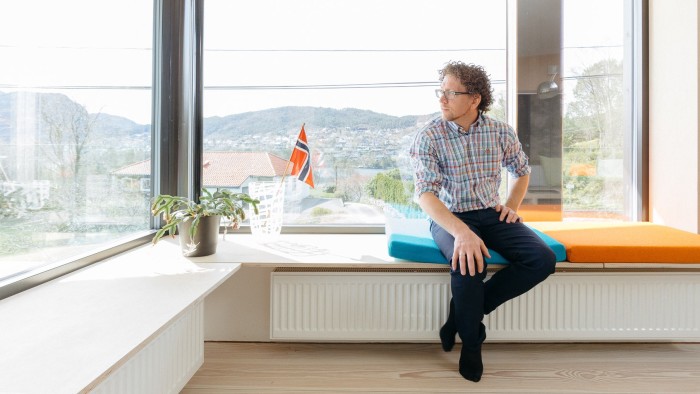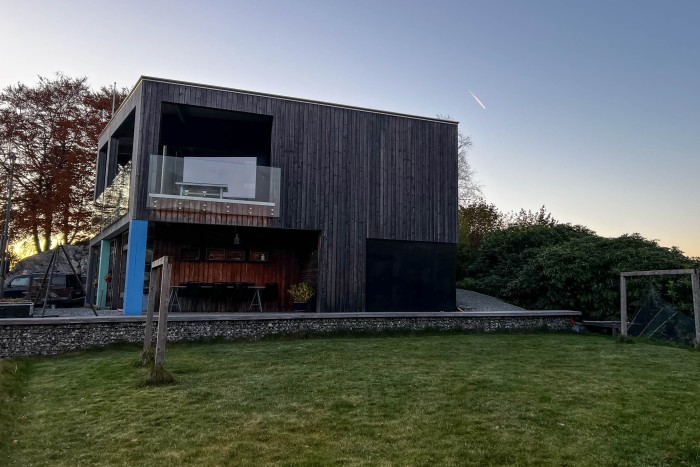Kebony’s timber tech helps combat deforestation

Simply sign up to the Sustainability myFT Digest -- delivered directly to your inbox.
When architect Henning Kongshavn Frønsdal was building his own house on the wind- and rain-beaten west coast of Norway, he wanted to use wood. A lot of wood. He ended up using 200 tonnes of it on Villa Sval — on everything from the façade and decking to window frames and the interior.
“There are not many clean products that can withstand the moist conditions where Villa Sval is situated,” he explains of the construction process a decade ago. Most wood used in cladding or decking is treated with pesticides and is often pressure-treated as well, making it less strong, Frønsdal says.
One alternative was natural pine corewood — a material used in Norway, from the Viking era to the 20th century. “But the problem is that you have to cut down old trees; there are not many left,” the architect says.
So he plumped for Kebony, the name of a product and the Norwegian company behind it. Kebony takes softwood and treats it with a bio-based liquid, which permanently modifies the cell walls and gives it the characteristics of a hardwood. It uses wood from sustainable forests that take only 25-30 years on average to grow versus 80-200 years for tropical hardwoods.
Kebony, which has been chosen as the winner in the manufacturing and construction category of the FT’s 2023 Tech Champions survey, says its product can help reduce both deforestation, sadly common with many tropical hardwoods, and carbon emissions.
“Wood from tropical rainforests is highly durable but it ends up with deforestation,” says Pavel Holub, chief technology officer at Kebony. “We use fast-growing sustainable wood, mostly pine, and transform it into something with similar performance and aesthetics of tropical wood.”

Kebony’s journey has been a slow one. It was founded in 1997 with a patent for kebonised wood, under which the wood’s cell structure is permanently changed by furfuryl alcohol, produced from agricultural crop waste. The impregnation process typically lasts about a month. “What takes nature up to 200 years, it takes us 25-plus days,” says Holub.
He concedes, however, that it took a long time for the company to gain traction. Its first factory was opened in Norway in 2009 and runs on hydropower, with its second following in Belgium in 2018, powered by bio-waste. In 2021, it raised €30mn in a funding round led by Jolt Capital and Lightrock to help with its expansion.
Frønsdal used 9,000 metres of Kebony for the exterior of Villa Sval. As time has passed, so the wood has taken on a silver-grey patina, helping it blend in with its surroundings more. It also needs no maintenance or subsequent treatment.
Holub says that speaks to a reason why many architects turn to tropical hardwood: its durability and minimal need for maintenance. Using standard wood for decking or terracing requires it to be repainted every two or three years, he points out.
Kebony since has grown away from its Nordic roots, enjoying success in Germany and the US as well as France and the Benelux countries. It is now looking to expand more in the Middle East, as well as in countries that introduce tougher regulations on tropical hardwood. Architects are increasingly looking to use natural materials, with wooden buildings becoming more popular in many countries.
But the recent economic slowdown has been tough on the company. Liesbeth Bracke, chief marketing officer, says that, for the first time in years, Kebony’s sales are dropping as it feels the pressure from the downturn in construction. “It has been a big hit, with a 30-40 per cent decrease in turnover,” she admits. Its revenues were €58mn last year, and it aims to reach €100mn by about 2026.
The company’s push into the Middle East is intended to make it less sensitive to the construction cycle, and it is looking at other industries, too, such as yachting. Kebony is also considering setting up production in the US, where it would use local wood such as southern yellow pine.
Most types of wood can be kebonised, but some are better in terms of speed, durability and cost. The company’s highest-quality product, Kebony Clear, uses wood from New Zealand, which Holub says is the only reliable source, even though the long-distance shipping involved raises questions about sustainability.
Pricing is another growing challenge. Kebony used to be cheaper than tropical hardwood but Bracke says the dumping of the latter in the US by exporters is making his own products uncompetitive. “Our view is the price point should be similar,” she says. “I don’t want sustainable materials to be more expensive.”

Comments